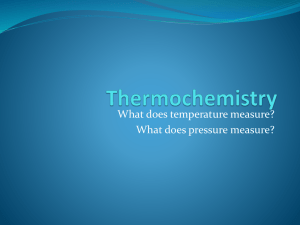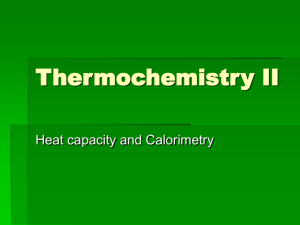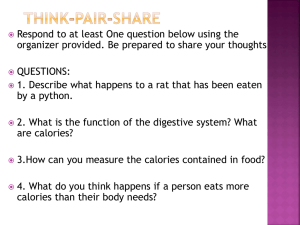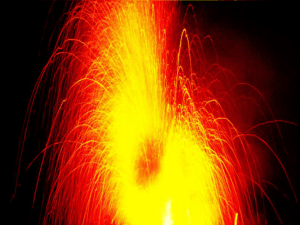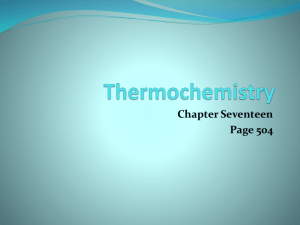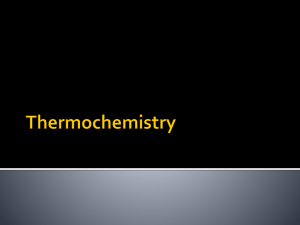Additional POGIL Notes - Daigneault (vachon) chemistry
advertisement
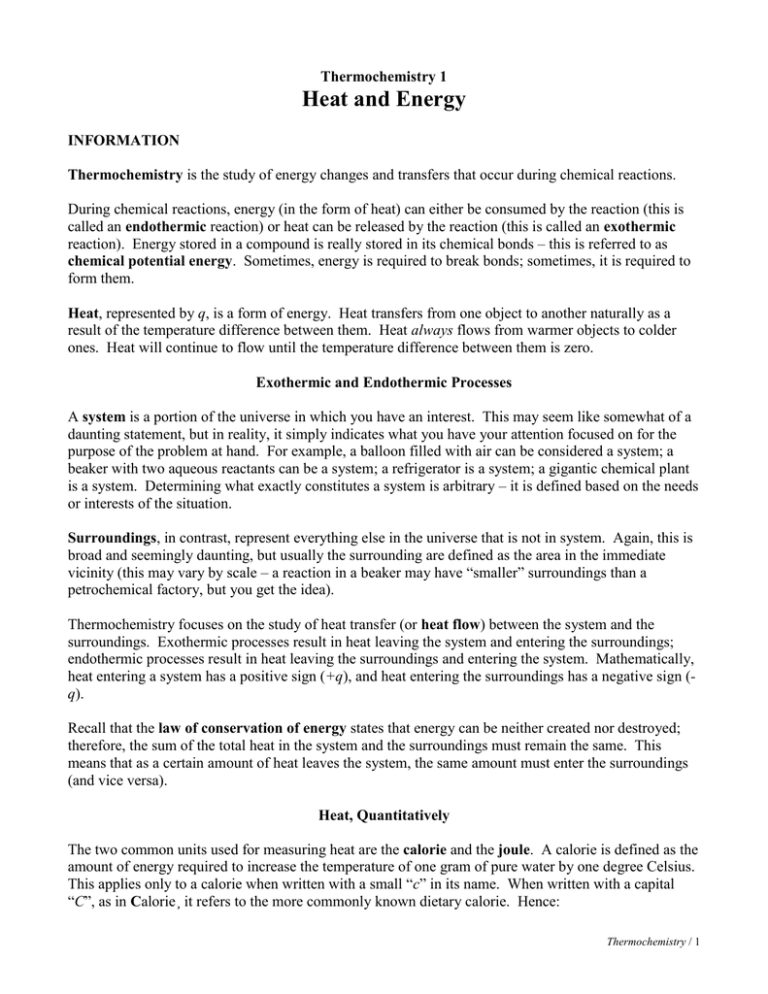
Thermochemistry 1 Heat and Energy INFORMATION Thermochemistry is the study of energy changes and transfers that occur during chemical reactions. During chemical reactions, energy (in the form of heat) can either be consumed by the reaction (this is called an endothermic reaction) or heat can be released by the reaction (this is called an exothermic reaction). Energy stored in a compound is really stored in its chemical bonds – this is referred to as chemical potential energy. Sometimes, energy is required to break bonds; sometimes, it is required to form them. Heat, represented by q, is a form of energy. Heat transfers from one object to another naturally as a result of the temperature difference between them. Heat always flows from warmer objects to colder ones. Heat will continue to flow until the temperature difference between them is zero. Exothermic and Endothermic Processes A system is a portion of the universe in which you have an interest. This may seem like somewhat of a daunting statement, but in reality, it simply indicates what you have your attention focused on for the purpose of the problem at hand. For example, a balloon filled with air can be considered a system; a beaker with two aqueous reactants can be a system; a refrigerator is a system; a gigantic chemical plant is a system. Determining what exactly constitutes a system is arbitrary – it is defined based on the needs or interests of the situation. Surroundings, in contrast, represent everything else in the universe that is not in system. Again, this is broad and seemingly daunting, but usually the surrounding are defined as the area in the immediate vicinity (this may vary by scale – a reaction in a beaker may have “smaller” surroundings than a petrochemical factory, but you get the idea). Thermochemistry focuses on the study of heat transfer (or heat flow) between the system and the surroundings. Exothermic processes result in heat leaving the system and entering the surroundings; endothermic processes result in heat leaving the surroundings and entering the system. Mathematically, heat entering a system has a positive sign (+q), and heat entering the surroundings has a negative sign (q). Recall that the law of conservation of energy states that energy can be neither created nor destroyed; therefore, the sum of the total heat in the system and the surroundings must remain the same. This means that as a certain amount of heat leaves the system, the same amount must enter the surroundings (and vice versa). Heat, Quantitatively The two common units used for measuring heat are the calorie and the joule. A calorie is defined as the amount of energy required to increase the temperature of one gram of pure water by one degree Celsius. This applies only to a calorie when written with a small “c” in its name. When written with a capital “C”, as in Calorie¸ it refers to the more commonly known dietary calorie. Hence: Thermochemistry / 1 1000 calories (cal) = 1 kilocalorie (kcal) = 1 Calorie (Cal) The energy denoted by a calorie, or by a Calorie, is measured by burning a sample under carefully monitored and controlled conditions and measuring the amount of heat released. When a candy bar wrapper indicates that the snack contains 100 Calories, this means that your body can break it down and acquire the equivalent of 100 Calories of energy. If one were to burn the same candy bar and measure the released heat, it would register as 100 Calories (or 100 kcal) of heat. This is, in fact, how Calorie content is determined for food. The SI unit of energy is the joule. A joule is a smaller unit of energy than a calorie; one joule of heat can only raise the temperature of one gram of water by 0.239 degrees Celsius. Hence: 1 joule (J) = 0.0239 cal or 4.184 J = 1 cal Heat Capacity Water, iron, and polyethylene plastic all require different amounts of heat to warm them. This property of matter is called heat capacity, and is dependent on both the mass of a sample and its chemical composition. A larger sample of water requires more heat to increase its temperature than a smaller sample, for example. Substance Asphalt Brick Concrete Glass, silica Glass, crown Glass, flint Glass, pyrex Granite Gypsum Marble, mica Sand Soil Wood cp J/g·C 0.92 0.84 0.88 0.84 0.67 0.503 0.753 0.79 1.09 0.88 0.835 0.8 0.42 Early scientists observed that different substances require different quantities of energy to change their temperature. Have you ever noticed that the hood of a car is hot to the touch in the summer sun, but a swimming pool is cool when you jump in? This is because a given mass of a certain substance may require more or less heat than the same mass of another substance to facilitate a change in its temperature. This property of matter (the amount of heat required to raise the temperature of 1 gram of it by 1 degree Celsius) is called specific heat capacity, or just specific heat. Specific heat must be measured; it cannot be calculated from other observations; it is reported as J/g·C, read “joules per gram degree Celsius.” Typically, specific heats are looked up on a table of common substances, like the one provided for common substances above. For reference, the specific heat of water is 1 J/g·C. Key Questions 1. An identical exothermic chemical reaction is carried out in two separate beakers. In one beaker, the solvent for the reactants is water; in the other, the solvent is an alcohol. Water and the alcohol have different specific heats. Without measuring, how could you determine which has the higher specific heat after the reaction is completed? 2. Assuming you are given the mass of a substance, the magnitude of desired temperature change, and a table of specific heat capacities, derive an equation that can be used to solve for the total heat required for this process. Recall that ΔT can be used to represent a change in temperature, Tf – Ti. Use the units of the values to make sure the equation works – i.e., the correct units cancel or multiply on one side to equal their configuration on the other. Thermochemistry / 2
